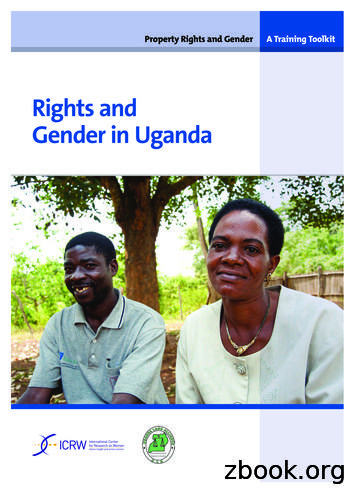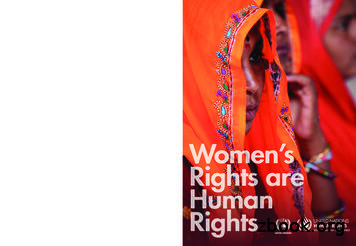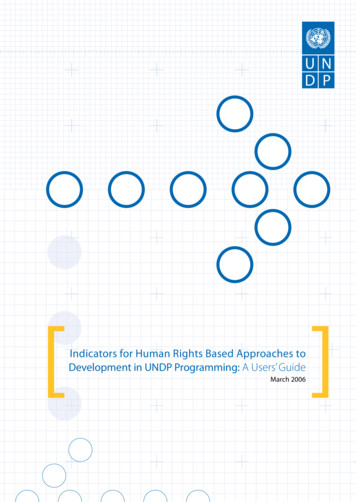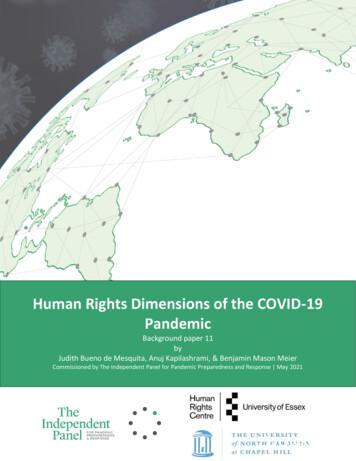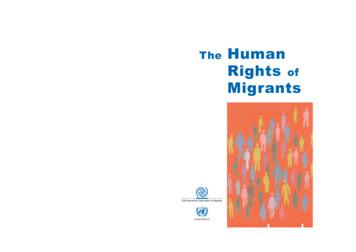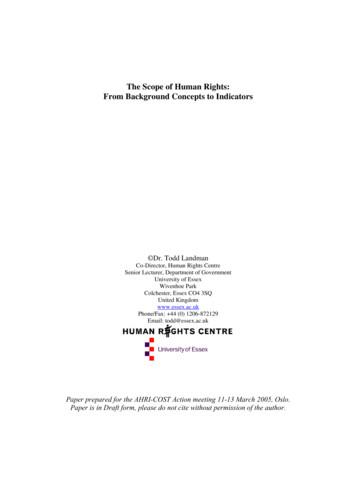Human Rights And Security In Central And Southern Somalia
8/2007ENGHuman rights and security in central and southern SomaliaJoint fact-finding mission by the Danish Refugee Council andthe Danish Immigration Service14 – 27 March 2007Copenhagen, August 2007Danish Immigration ServiceRyesgade 532100 Copenhagen ØPhone: 00 45 35 36 66 00Web: www.newtodenmark.dkE-mail: us@us.dk
Overview of fact-finding reports published in 2006 and 2007Børneforsorg, børnehjem og forholdene for forældreløse børn i Sri Lanka, Rapport fra fact-findingmission til Colombo, Sri Lanka, 26. november – 5. december 20052006: 1Sygdomsbehandling i Sri Lanka, Rapport fra fact-finding mission til Colombo, Sri Lanka, 26. november– 5. december 20052006: 2Familieret og verifikation af dokumenter samt behandlingsmuligheder m.m. i Cameroun, Rapport frafact-finding mission til Yaoundé, Buea og Bamenda, Cameroun, 17. – 27. marts 20062006: 3Familieret og verifikation af dokumenter samt behandlingsmuligheder m.m. i Ghana, Rapport fra factfinding mission til Accra, Ghana, 10. – 17. marts 20062006: 4Rapport om fængselsforhold i Nigeria, Fact-finding mission til Lagos og Abuja, Nigeria, 12. – 21.december 20062007: 1Menneskehandel (trafficking) i Nigeria, Rapport fra fact-finding mission til Lagos og Abuja, Nigeria, 12.– 21. december 20062007: 2Menneskerettighedsforhold i den Demokratiske Republik Congo (DRC), Rapport fra dansk-norsk factfinding mission til Kinshasa, DRC, 9. – 24. januar 20072007: 3Familieret og verifikation af dokumenter samt behandlingsmuligheder m.m. i den DemokratiskeRepublik Congo (DRC), Rapport fra dansk-norsk fact-finding mission til Kinshasa, DRC, 9. – 24. januar20072007: 4Syria: Kurds, Honour-killings and Illegal Departure, Report from a fact finding mission to Damascus, 1522 January 20072007: 5Praktik i de ukrainske landbrugsuddannelser, Rapport fra fact finding mission til Kiev, 5.-9. februar20072007: 6Risiko for forfølgelse fra tidligere medlemmer og ledere af oprørsbevægelser i Liberia og mulighed forbeskyttelse, Rapport fra fact-finding mission til Monrovia, Liberia, 22. – 27. april 20072007: 7Human rights and security in central and southern Somalia, Joint fact-finding mission by the DanishRefugee Council and the Danish Immigration Service, 14 – 27 March 20072007: 8
Table of contents1 Introduction.32. Political developments, armed conflict and security in central and southern Somalia.5Police force .10Areas of relative stability in central and southern Somalia .10The National Reconciliation Conference.113. Human rights issues .163.1. Monitoring human rights in central and southern Somalia.163.2. Minority populations.183.2.1. Ethnic Oromos .203.3. Internally Displaced Persons (IDPs) .203.4. Returnees.243.4.1. Returnees from Europe and Internal Flight Alternative (IFA) .243.4.2. Returnees from Ethiopia .253.5. Forced recruitment, child soldiers and forced labour .263.6. Risk of double jeopardy .293.7. Clan protection.293.8. Cross clan marriages .303.9. Women .313.9.1. Female Genital Mutilation (FGM).323.9.2. Victims of rape.323.9.3. Re-education trips to Somalia .343.9.4. Orphans .343.10. Persons affected by HIV/AIDS.353.11. Religious conversion and situation for Christians .363.12. Homosexuals.363.13. Politically motivated persecution and assassinations.383.13.1. Persons affiliated with the UIC and other opposition groups .383.13.2. Persons affiliated with the TFG and the TFI.40
Human rights and security in central and southern Somalia3.13.3. Human rights activists, members of civil society groups and journalists.414. Organisations, authorities and individuals consulted.435. Bibliography .456. Acronyms and abbreviations .462
Human rights and security in central and southern Somalia1 IntroductionThe Danish Immigration Service and the Danish Refugee Council undertook a joint fact-findingmission to Nairobi, Kenya in March 2007. The delegation originally planned also to visitMogadishu in Somalia. However, the security situation in Mogadishu deteriorated severely duringMarch, and for security reasons the delegation was advised not to travel to Mogadishu.Therefore, the information presented in the delegation’s report is based on information provided bysources consulted in Nairobi. The sources consulted comprised United Nation (UN) agencies, theEuropean Union, Non-Governmental Organisations (NGOs) and International Non-GovernmentalOrganisations (INGOs), individuals, consultants and a representative of the Somali government. 1The Royal Danish Embassy in Nairobi kindly assisted the delegation with advice and identificationof a number of the sources consulted. The British Home Office, Border and Immigration Agency,Country of origin Information Service has proof read the report. However, the delegation’s reportand its content is solely the responsibility of the Danish Immigration Service and the DanishRefugee Council.It should be noted that during the writing up in March-April of the delegation’s report the armedconflicts in Somalia escalated severely, especially in Mogadishu. It was therefore decided to includeinformation from various news agencies, NGOs as well as UN reports and other written sourcesconcerning the most recent developments in Somalia. Therefore the delegation’s report includesinformation on developments in Somalia up to the end of June 2007. The delegation found itimperative that its report was not concluded in the midst of chaos and the heaviest fighting inSomalia for many years.During the mission in late March 2007 the delegation was informed that the fighting in Somaliamost likely would cease after a few weeks. However, the fighting continued at the end of Marchand throughout April, and it culminated at the very end of April 2007 with extremely heavy fightingin Mogadishu. So far the Ethiopian forces and the Transitional Federal Government (TFG) have notsucceeded in totally quelling the insurgents that fight against the Ethiopian troops in Somalia aswell as against the TFG and its allies.The recent fighting was described as the worst fighting in Somalia since the catastrophe in the early1990’s. The political outcome of the fighting in 2007 is not yet clear, but from a militaryperspective is seems as if the Ethiopian troops and the TFG had defeated the Union of IslamicCourts (UIC) by early May 2007. Several hundred thousands of civilians fled the fighting inMogadishu and many others have relocated in the city between February and April 2007, and only afew had returned to the city by mid May 2007.The delegation to Nairobi comprised Mette Marie Honoré, Senior Legal Adviser, Danish RefugeeCouncil and Jens Weise Olesen, Senior Adviser, Documentation and Project Division, Danish1All UN-organisations as well as most INGOs operating in central and southern Somalia have their headoffices inNairobi and not in Somalia. This is due to the fact that the security situation in central and southern Somalia has beenand still is one of the most dangerous places for international organisations to work in.3
Human rights and security in central and southern SomaliaImmigration Service. The delegation’s report is a joint product by the Danish Immigration Serviceand the Danish Refugee Council.4
Human rights and security in central and southern Somalia2. Political developments, armed conflict and security in central andsouthern SomaliaThe present Transitional Federal Government (TFG) in Somalia was formed in 2004, but internaland physical divisions within the TFG as well as insecurity in central and southern Somalia, and inMogadishu particularly, hindered it from being a functioning, unified government. However, inearly 2006 the TFG became physically unified for the first time in Baidoa. Insecurity in Mogadishuhad forced the TFG to establish itself elsewhere in Somalia and for some time it was dividedbetween Baidoa and Jowhar. This brief period of fragile optimism soon vanished as the Union ofIslamic Courts (UIC) in Mogadishu suddenly took control of the capital. UIC is a union of variousSharia courts, and the Hawiye clans in particular supported it. During the spring of 2006 the UICfought against the warlords in central and southern Somalia and a number of former Mogadishubased warlords founded a coalition that was named Alliance for the Restoration of Peace andCounter-Terrorism (ARPCT). However, the UIC defeated ARPCT in May 2006 and from then onUIC gradually took control of most of central and southern Somalia, including Mogadishu. UICnever gained control of Baidoa, the seat of the TFG.Failed peace talks in Khartoum, Sudan between the UIC and the TFG resulted in an Ethiopianintervention in Somalia. On 22 December 2006 heavy fighting broke out around Baidoa betweenEthiopian troops and the TFG on one side and the UIC on the other. The UIC was quickly defeatedand soon after the Ethiopian troops entered Mogadishu and drove the UIC out of the city and otherareas of central and southern Somalia. Following the ousting of UIC from Mogadishu theTransitional Federal Parliament (TFP) swiftly decided to relocate from Baidoa to Mogadishu. ByJanuary 2007 the TFG and its supporter, the Ethiopian forces, controlled most of central andsouthern Somalia, including Mogadishu.On February 20 2007 the UN Security Council authorized the African Union (AU) to establish amission in Somalia for six months. The aim of the mission is to support the national reconciliationconference. The Security Council also requested the General-Secretary to send a technicalassessment mission to look into the possibility of a UN peacekeeping operation following thedeployment of the African Union Mission in Somalia (AMISOM). 2The United States (US) government has been deeply concerned about the potential threat of anIslamic state in Somalia, and the Office of the Coordinator for Counterterrorism has reported: ”Therise of the Council of Islamic Courts (CIC) 3 and their expansion of control into southern and centralSomalia created a more permissive operating environment and safe haven for foreign terrorists. InJune, the CIC gained control of Mogadishu and were initially welcomed as bringing a modicum ofpeace and stability to the city. Over the course of the following months, the broader CICorganization was hijacked by al Shabaab (“The Youth”), a small, extremist group affiliated with AQ2Security Council, Security Council Authorizes Six-Month African Union Mission in Somalia, Unanimously AdoptingResolution 1744 (2007), Security Council 5633rd Meeting (PM), SC/8960, New York, 20 February 2007.3Council of Islamic Courts (CIC) is also named Somali Council of Islamic Courts (COSIC) by some sources.CIC/COSIC was formed in June 2006. Some sources only speak of the Union of Islamic Courts (UIC), which wasformed in early 2006 by the merging of a number of Sharia courts in Mogadishu. For practical reasons the term UIC isbeing applied throughout this report.5
Human rights and security in central and southern Somalia[al-Qaeda] that consists of radicalised young men, between 20 and 30 years of age. The CIC beganto pursue an increasingly hostile strategy of military expansion and aggression designed to provokea broader regional conflict. Al Shabaab militia participated in CIC military offensives and served assomething akin to a "special forces" unit for the CIC. Although not formally a part of the CICstructure, members of al Shabaab held senior positions within the CIC, particularly in the security,finance, and education departments. The group was reputed to be extremely violent and brutal, andits members are suspected of murdering an Italian nun in Mogadishu in September, targetedassassinations of dozens of Somali nationals inside Somalia, including the murder of peace activistAbdulqadir Yahya Ali in July 2005, and the murder of foreign aid workers in the self-declaredRepublic of Somaliland in late 2003 to early 2004. In late June [2006], the CIC elected HassanDahir Aweys chairman of the CIC Shura Council. Aweys is designated as a terrorist by the UnitedStates and the United Nations because of his links to AQ, the Taliban, or Usama bin Laden.” 4The fighting between the TFG, the Ethiopian forces and remnants of the UIC and other anti-TFGmilitias (mostly Hawiye supported militias) continued during the period January to May 2007. TheUN has described the battles in Mogadishu as the worst fighting since 1991. Clan fighting also tookplace in other locations in central and southern Somalia, including in Kismayo (between theMarehan and the Majerteen) and south of the city.United Nations High Commissioner for Refugees (UNHCR) reported in May 2007 that over394,000 persons – more than one third of Mogadishu’s estimated population –fled the city between1 February 2007 and the end of April 2007. The majority of the Internally Displaced Persons (IDPs)are women, children and the elderly. 5During the last two weeks of April 2007 Mogadishu experienced the most extreme fighting betweenthe TFG/Ethiopian troops and anti-TFG/Ethiopian militias. In early May the UNHCR reported thatonly about 800 IDPs had returned to the city, a figure far lower that had been reported in the localmedia. The UN Office for the Coordination of Humanitarian Affairs (OCHA) also reported in earlyMay: “the overwhelming majority of those who fled Mogadishu in the past two to three months arenot yet attempting to return, largely due to fear of renewed fighting.” OCHA added that thereturnees are mainly urban poor who are coming back to Mogadishu in an attempt to restore theirlivelihoods. There are reports of IDPs arriving in Mogadishu – particularly Oromos – beingharassed and arrested. Returns may be further discouraged by the fact that some public buildingsformerly occupied by IDPs were destroyed in the fighting, as well as tension over the planned useof public buildings that were, until recently, occupied by IDPs. 6On June 22 2007 OCHA reported that “Insecurity and violence in Mogadishu continued, withgrenade attacks, assassinations and roadside bombs resulting in troop and civilian deaths, includingchildren. The TFG has continued with house-to-house weapons searches and arrests, and movementwithin the city is said to be severely restricted and dangerous. The violence, which has escalated4U.S. Department of State, Country Reports on Terrorism, Chapter 2 – Country Reports: African Overview, Somalia,released by the Office of the Coordinator for Counterterrorism, April 30, 2007.5UNHCR-Somalia, IASC Somalia – Protection Cluster Update: 4th May 2007, Population Movement Tracking (PMT)and Protection Monitoring Network (PMN), Nairobi 4 May 2007.6OCHA-Somalia, Situation Report # 38 – 04 May, 2007.6
Human rights and security in central and southern Somaliasince the 13 June postponement of the National Reconciliation Conference, is restricting livelihoodactivities in the city and the ability of aid agencies to operate. The TFG’s announcement on 19 Junethat it is offering amnesty to former members of the ICU (except those the government deemslinked to terrorist groups) has of yet had no apparent effect on security in Mogadishu. In an effort tostem the violence, the TFG announced a 7pm curfew, effective today, 22 June.” 7Furthermore OCHA reported “An atmosphere of fear has intensified within the population ofMogadishu. Intimidation is obstructing the implementation of humanitarian activities. On 18 June,four staff members of a Somali NGO – including the Director – were arrested. Though the fourwere released on 20 June, the Director was re-arrested the following day and interrogated beforebeing released again.” 8Finally OCHA reported “Unrest continued in other parts of South/Central, spreading last week toBaidoa, former seat of the TFG. Two grenade attacks in Baidoa – targeting a cinema (14 June) anda government-run bank (17 June) – resulted in six deaths, including one child, and several injured.A 9pm curfew has since been imposed on the town. Tensions are high in Kismayo as residentsanticipate an outbreak of fighting between TFG troops and local militia who have been in control ofthe key port city. Recent clan fighting in Kismayo over a land dispute has already resulted in anestimated 52 deaths in Berhano settlement. Meanwhile, there have been reports from protectionpartners of arbitrary arrests by Kenyan police near the Kenyan border in Kulbiyo, Dobley andAmumua. This follows the discovery last week near Mandera of the bodies of two Kenyanpolicemen who disappeared 9 June while patrolling the border.” 9During the delegation’s mission in march 2007 an international organisation (A) explained that theinsertion of Ethiopian troops was a way of reinforcing and legitimating the TFG administration. Theintervention was backed by several states, including the United Kingdom, Kenya and the UnitedStates, and the UIC was defeated very quickly by the Ethiopian troops.An international organisation (A) estimated that between 1,000 and 1,500 persons were killed oneach side during the war in December 2006. There were a number of human rights violations duringthe war and both sides committed these violations. Summary executions might have taken place.Many of the UIC fighters were poorly trained and they faced well-equipped and well-trainedEthiopian soldiers. It was a
2 Security Council, Security Council Authorizes Six-Month African Union Mission in Somalia, Unanimously Adopting Resolution 1744 (2007), Security Council 5633rd Meeting (PM), SC/8960, New York, 20 February 2007. 3 Council of Islamic Courts (CIC) is also named Somali Council of Islamic Courts (COSIC) by some sources. CIC/COSIC was formed in June .
Rights and gendeR in Uganda · 3 Rights & Human Rights Background Rights The law is based on the notion of rights. Community rights workers need to understand what rights are, where rights come from, and their own role in protecting and promoting rights. Community rights worker
A Human Rights Perspective by David Shiman Raising Children with Roots, Rights and Responsibilities: Celebrating the UN Convention on the Rights of the Child by Lori DuPont, Joanne Foley, and Annette Gagliardi Lesbian, Gay, Bisexual, and Transgender Rights: A Human Rights Perspective by David M. Donahue The Human Rights Education Handbook:
make up the International Bill of Human Rights. The provisions of the two Covenants, as well as other human rights treaties, are legally binding on . of their human rights, for example marriage and the family. 6 WOMEN’S RiGHTS ARE HUMAN RiGHTS The Convention defines d
stream human rights into development projects and to monitor and implement a human rights-based approach (HRBA) to development more generally. From the side of human rights, the demand has come from recognition among the human rights treaty monitoring bodies, the Office of the High Commissioner for Human Rights, and a variety of Special .
human rights impact of COVID-19 and COVID-19 responses on human rights; the role of global health and human rights governance actors, including the WHO, World Health Assembly, Office of the High Commissioner for Human Rights and UN human rights oversight bodies, suggesting areas of action for
consider the human rights dimension of contemporary migration. Under the Universal Declaration of Human Rights (created fifty years ago), human rights are universal (they apply everywhere), indivisible (political and civil rights cannot be separated from social and cultural rights); and inalienable (they cannot be denied to any human beings).
the concept of human rights, this essay will examine the tensions between human rights and state sovereignty, the challenges to the universality of human rights, the enumeration of rights recognized by the international community, and the means available to translate the high aspirations of human rights into practice. II.
Introduction 1 1.The Scope of Human Rights 2 1.1. Categories of human rights 2 1.2. Dimensions of human rights 5 2. From Concepts to Indicators 10 3. Extant Measures 13 3.1. Rights in principle 13 3.2. Rights in practice 15 3.3. Government policies and outcomes 24 4. Lacun

